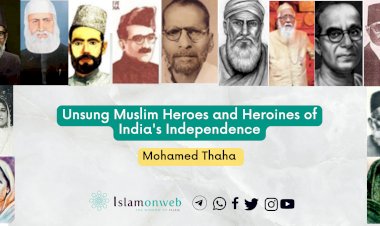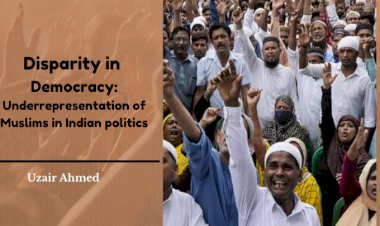Demographic Myth about the Muslim Population in India
Last month, in a speech, Prime Minister Narendra Modi referred to Muslims in India as 'those who have a large number of children'. Just a few days later, the Economic Advisory Council to the Prime Minister (EAC-PM) released a report titled "Share of Religious Minorities: A Cross-Country Analysis (1950–2015)" prepared by economist Shamika Ravi, highlighting that the share of Hindus as a proportion of India's population declined from 84.68% to 78%. The Muslim proportion, meanwhile, has risen from 9.84% to 14%. The timing of the report, its use of almost decade-old data miscalculations, and so many other flaws in the report caused a stir. It triggered a political uproar among political parties and individuals, and once again, the Muslim population has become a point of discussion.
This clickbait paper tried to claim that minority religious groups in India are not just protected but indeed thriving in India, suggesting a 'conducive environment' for increasing diversity. The report also underlined how most countries have seen their majority religion adherents decline, and the Indian experience vis-à-vis the proportion of decline of Hindus is unexceptional in the light of broad trends globally, especially in European and developed nations. But the truth is quite the opposite.
Rhetoric, propaganda, and false narrative
Actually, the Prime Minister's Economic Advisory Council report poses many serious questions and further leads to the false narrative and propaganda that were started by the BJP or PM Modi to polarize the people during the election season in India.
Firstly, the timing of the report: Why has EAC-PM released this study now? Although the data used in the report is almost a decade old (1950–2015) and has been known since 2011 in India, why has it been discussed this threadbare at this instant? The 'working paper' said that it was produced in a bid to counter "noise in several quarters" about India's tilt towards majoritarianism and attacks on Muslims and Sikhs. What is cited as "noise" were reports published by The Time, The Guardian, and The Wire targeting minorities. The paper's intentions are clear here, trying to set a narrative that proves the discrimination and violence reports were wrong. While the fact is that the increase in the population of any group has nothing to do with the state, as The Hindu in an editorial column said, 'linking demographic shifts directly to state actions is problematic.'
The report is being used to substantiate the old Hindutva myth of Hindus being in danger of becoming a minority in a country of their own, and India will soon become an Islamic Republic. The authors of this paper don't have a causative explanation of demographic change by ascribing Muslim numbers in India to 'progressive policies and inclusive institutions. The author will then have to explain if India's Parsi and Jain populations (whose numbers they reference) are declining due to hostile state policies.
Secondly, if one were to apply the same calculations to the Muslim population, it would show the Buddhist population had increased by 1520% during this time; in fact, their share had risen from 0.5% to 0.8% in the total population. The working paper instead refers to this as just a 'noticeable increase'. This is a bizarre attempt, and the distorted analysis done by EAC-PM can be seen in this calculation.
Thirdly, according to the National Family Health Survey (NFHS 5-2019-21), Muslim women's total fertility rate (TFR) saw a drop of 2.05 as against Hindu women's TFR of 1.36. This is neither mentioned in the report nor considered a parameter.
Fourthly, in showing changing shares of religious groups' populations, the EAC-PM's working paper has expressed the difference in population between 1950 and 2015 as a percentage of the population of those respective religious groups in 1950. As a result, the Muslim community's difference in the share of the population, which is coming to a rise of 4.25% points, is being expressed as a 43.15% increase compared to the Muslim population as of 1950. However, this data presentation has not been used for Buddhists and Jains, as mentioned earlier.
The actual problem is that people understand the increase in population as proof of all being well with Indian Muslims. Last year, Union Finance Minister Nirmala Sitharaman, in response to a question by the Peterson Institute for International Economics (PIIE) president about Muslims in India, said, 'India has the second largest Muslim population in the world, and the population is only growing in numbers. This is the general perception: if their lives are difficult, will the Muslim population be growing faster than what it was in 1947?'
PFI's deep concern for the EAC-PM report
The Population Foundation of India, an independent think tank that promotes and advocates effective formulation, expressed its deep concerns on 9 May about media reports misrepresenting the data set out by the EAC-PM. It said that media outlets were misreporting the findings contained in the working paper "to spread alarm regarding the growth of the Muslim population." According to PFI, such interpretations are inaccurate, misleading, and baseless.
"Minorities are safe and thriving in India." The paper calls this 'particularly remarkable' when compared to data from South Asian countries like Bangladesh, Pakistan, Sri Lanka, Bhutan, and Afghanistan, where the share of the majority religious denomination has increased and the minority has shrunk alarmingly. Meanwhile, the PFI pointed out in its statement that successful family planning programs in Muslim-majority countries like Bangladesh and Indonesia have resulted in lower birth rates compared to India. These countries have achieved this through higher levels of female education, greater employment opportunities, and better access to contraceptive choices. The Population Foundation of India called for responsible reporting, adding that "it is essential to present data accurately and contextually, highlighting the role of education, income, and socio-economic development in shaping demographic trends.
Real facts and figures
The most authentic data on population is only available from the Census. According to the Census of 2001 and 2011, the Muslim population's decadal growth declined from 36.02% to 24.04%, and the Hindu population's decadal growth saw a decline from 20.35% to 16.76%. In terms of the total fertility rate, the National Family Health Survey 5 (NFHS 5) 2019–21 showed that the TFR for Muslims was 2.36, which is very close to the replacement rate of 2.1. It has been the sharpest decline, from a high of 3.59 in 1998–99 to 2.36 in 2019–21. The Hindu TFR is 1.94, and, therefore, demographers are optimistic about the Muslim population eventually stabilizing by the end of the century. Many other think tanks and organizations, even the United Nations Population Fund, observed in 2022 that "good news is that India's population growth appears to be stabilizing." It means India's religious composition has remained largely stable as fertility rates have declined across religious groups, with the sharpest drop recorded among Muslims.

Another important thing is to know or find out the share of any group or community in the national pie; we should look at a group's educational conditions. The growth in the population is not the right parameter to judge the group's status in the country's body politic. In fact, high fertility rates are indicative of educational, social, and economic backwardness. Therefore, government data show that educating girls, not marrying them off early, and creating more awareness about family planning measures help reduce fertility levels. According to NFHS 5, the fertility rate of Muslim women varies according to region. For instance, the TFR of Muslim women in Bihar was 3.6 in 2019–21, much higher than the 2.0 in Maharashtra. Similarly, the TFR of Muslim women was 1.9 in Tamil Nadu and 2.0 in Karnataka, much lower than the 2.7 in Jharkhand and 2.4 in Rajasthan. Thus, Hindu TFR in Bihar (2.88) and Uttar Pradesh (2.29) is much higher than Muslim TFR in Kerala, Tamil Nadu, Andhra Pradesh, and Telangana.
The answer to why fertility levels drastically vary among Muslim women across different regions lies in how developed a state is, not just economically but also socially. It clearly shows that fertility decline is influenced by development factors rather than religious affiliation. "The number of children has more to do with the development than religion," as a data point published by The Hindu with this title.
Conclusion
On the one hand, the government of India withdraws many bills pertaining to population control, denying this coercive route and presenting the international data that India's population has stabilized throughout the years. And on the other hand, it creates a demographic myth, a false narrative, and propaganda to polarize the population and spread hatred among groups. The only point is that we must focus on educating girls, stopping child marriage, increasing access to family planning measures, and working towards the educational and economic empowerment of Muslims.
References
- Clickbait paper, Editorial, The Hindu, 13 May, 2024
- A well-intentioned study and a demographic myth, Indian Academic, Faizan Mustafa, Column, The Hindu, 13 May, 2024
- Minorities Thriving In India: EAC-PM Paper, The Times of India, 10 May, 2024
- Fact Check: Old Data, New Spin in PM-EAC Report on India's Population, Banjot Kaur, The Wire, 10 May, 2024
- The Controversy Over a New Population Study From India, Astha Rajvanshi, Time Magazine, 10 May, 2024
- Findings of EAC-PM working paper being misreported, says Population Foundation of India, Abhinay Lakshman, The Hindu, 9 May, 2024
Endnotes
- Economic Advisory Council to the Prime Minister (EAC-PM)
- Share of Religious Minorities : a Cross-Country Analysis (1950-2015)
- Religious Characteristics of States Dataset, 2017 (RCM-Dem)
- National Family Health Survey (NFHS 5), 2019-21
Author: Uzair Ahmed is a PG first-year student, Dept. of Civilizational Studies at Darul Huda Islamic University
Disclaimer
The views expressed in this article are the author’s own and do not necessarily mirror Islamonweb’s editorial stance.
























Leave A Comment